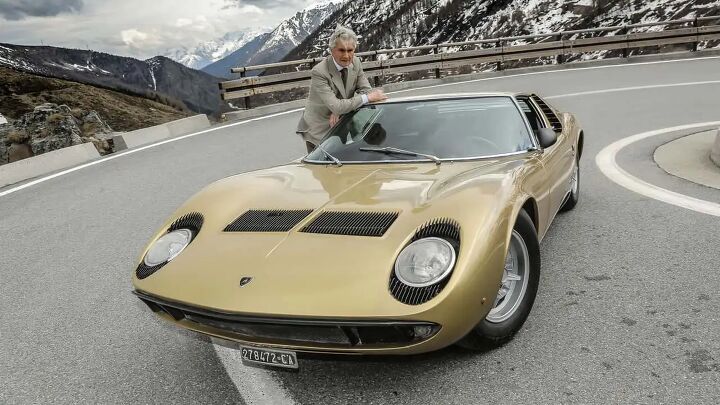
The world lost one of its preeminent car designers today, as Marcello Gandini has passed away at the age of 85. Though perhaps best known for the flashy and outrageous Lamborghini Countach, Gandini’s pen was applied to many other Italian, German, French, British, Japanese, and Swedish concepts and production designs. Gandini’s prolific portfolio of work made a permanent mark on automotive design.

Born on August 26th, 1938 in Turin, Italy, Marcello Gandini was the son of a conductor. Interested in automotive design from a young age, he first attempted to break into the business in 1963 at the age of 25. Speaking with Giuseppe Bertone (1917-1997), his employment was ultimately denied by Giorgietto Giugiaro (b. 1938), a man of the same age who was the head of design at Bertone.
Bertone kept Gandini in mind, and in two years when Giugiaro left the firm Gandini was immediately hired. He would work for Bertone for a total of 14 years, and created a dedicated studio, Stile Bertone. The studio worked exclusively on concept cars and prototypes, and before long auto manufacturers hired Bertone so Gandini could pen their design.

It was at Bertone that Gandini would draw up the majority of Lamborghini’s early vehicles, catapulting the new brand beyond the super car and into exotica territory with his daring, forward-looking designs. The first Gandini-designed Lamborghini was the Miura (1966-1973). It was one of the first examples of a car with a mid-engined layout and only two seats, and used a transverse V12.

In 1967 Gandini designed the four-seat Marzal concept, with its see-through glass door panels, and a silver metallic interior. The design was distilled into the production Espada, the company’s first four-seat grand touring sports car. Espada was a size up from Lamborghini’s previous 2+2 designs at the behest of Ferruccio Lamborghini.
The following year Gandini invented the scissor door, used on the Alfa Romeo 33 Carabo concept. The design was put into production a few years later in the Lamborghini Countach, and continued on its successor the Diablo. Numerous other cars have used the Gandini scissor door design over the years. Alfa Romeo selected Gandini’s design for one production vehicle, the Montreal of 1970.

His work on the 2+2 Lamborghini Urraco show car in 1970 inspired Ferrari, who ventured away from their Pininfarina ways and employed Bertone to design the Dino 308 GT4. The Dino was a 2+2, the first V8 Ferrari, and the only Bertone design Ferrari ever used. On the Lamborghini front, Gandini also designed the Bravo concept, Jarama, P140 concept, P147 Acosta concept, and the Diablo prototype. The Diablo design was ultimately finalized by Tom Gale at Chrysler, who also designed the LX platform Chrysler 300.

Gandini designed multiple vehicles for Fiat in the 1970s, including the midsize Dino coupe, one of the company’s final large family cars the 132, and the X1/9 that was marketed in the United States as the Bertone X1/9 by Malcom Bricklin. Though low in production figures, Gandini designed what became one of the most famous rally cars in the world, the Lancia Stratos. The Stratos won the World Rally Championship in 1974, 1975, and 1976. Stratos was the result of Lancia taking a chance on Bertone, as (like Ferrari) the company had previously used Pininfarina to design its vehicles.

In between high-end exotic designs, Gandini also designed mass-production vehicles. He penned the very first BMW 5-Series of 1972. The Innocenti Mini, an Italian take on the Austin Mini debuted in 1974. A year later the first generation Volkswagen Polo launched with a Gandini design. Polo was accompanied by the more upmarket Audi 50, which was also designed at Bertone. Gandini shaped the five-door Citroen BX production car, and created a very similar concept called the Tundra for Volvo.

Gandini designed three different cars for Italian sports car maker Iso, of which the Lele was produced from 1969 to 1974. Around that time he was also responsible for the design of the Maserati Khamsin. Maserati worked with Gandini independently after Bertone, on cars like the Ghibli (1992-1998). He also designed the front-drive Citroen SM based Maserati Quattroporte of 1976, the rear-drive BiTurbo based Quattroporte of 1994, and the 1990 Shamal coupe.

Along the way, Gandini developed a signature characteristic: A forward and upward shaped rear wheel arch. It persisted through decades of his work, and made spotting a Gandini design easy. More exotic car work in the Seventies was completed for De Tomaso, where he designed the Pantera, and in the 2000s the Bigua which was sold as the Qvale Mangusta in the United States. Nearly on par with the Countach for outlandish design was the Cizeta-Moroder V16T. The 6.0-liter 16-cylinder hyper car saw only 13 examples produced, and looked fairly similar to the Diablo.

Gandini went on to design the crazy rear-engined Renault 5 Turbo of 1980, and the important second generation Renault 5 in 1984. Renault also hired him later to design the Magnum, a European market heavy-duty truck that was produced from 1990 to 2013. Gandini left Bertone officially in 1980 to work independently on automotive, interior, and industrial design projects. Work in the Eighties and Nineties continued with production vehicles from De Tomaso and Maserati, along with concepts like the Nissan AP-X, and the prototype of the Bugatti EB110. He also dabbled in residential architecture, interiors, and helicopter styling.

Gandini’s design legacy on the automobile is permanent. Impactful vehicles like the Miura, Countach and Stratos are the stuff of posters, or perhaps screen wallpapers in more modern times. Today we bid farewell to a legend.
[Images: Lamborghini, seller, BMW, seller, Maserati, BaT, Renault, BaT]
Become a TTAC insider. Get the latest news, features, TTAC takes, and everything else that gets to The Truth About Cars first by subscribing to our newsletter.

